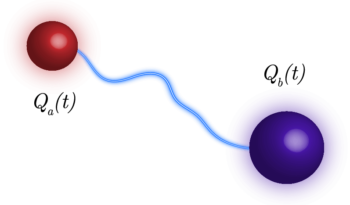We were taught that grounding a conductor (by connecting it to the ground with a wire) means fixing its electric potential to zero. That’s right, but what is the physical mechanism that fixes to zero the electric potential? Let’s see how grounding a conductor works in physical terms.
The electric potential of a charged sphere
First of all, we have to recall the electric potential of a charged sphere. So, let’s assume that a conducting sphere of radius \(R\) is charged with total charge \(Q\). The electric charge will be uniformly distributed on the sphere surface (warning: We can guarantee uniform distribution of the charge on the surface in the case of a sphere only. If the conductor has any other form, the distribution of the charge will be nonuniform). The electric potential is just
\begin{equation}
\phi(r)=\begin{cases}k\frac{Q}{R},& r\leq R\\ k\frac{Q}{r},&r\geq R\end{cases}
\end{equation}
where \(r=|\vec{r}|\), and \(k=(4\pi\epsilon_0)^{-1}\).
We see that the electric potential on the entire sphere is constant and for a finite value of \(Q\) will be very small when \(R\) is large enough. Now let’s consider the entire planet as a giant conducting sphere. The radius of our planet is about 6370 kilometers. large enough to consider its electric potential as practically zero. Any finite (and reasonable) variation in its electric charge, will change its electric potential, but it will remain very near to zero anyway. Our planet is not a perfect sphere, but that fact just introduces small changes in the potential distribution while it remains almost zero.
Recall that when conductors are put in contact, they reach the equilibrium state with equal potential for all of them. Let’s see through one example, what this shared potential is.
The electric potential of two conducting spheres connected by a wire
Our goal is to understand the physical mechanism behind fixing to zero the electric potential of any conductor by grounding it. For the sake of simplicity, let’s consider first the problem of determining the electric potential of two conducting spheres of radius \(R_1\) and \(R_2\) respectively. The two spheres are far apart in such a way that the electric potential of any of them is negligible in the vicinity of the other. Before connecting the spheres, the one with radius \(R_1\) is charged with a total charge of \(Q\) while the other one is uncharged. Thus, in the beginning, the electric potential of the spheres are \(\phi_1=kQ/R_1\), and \(\phi_2=0\) respectively.
After connecting the spheres with help of a wire, they reach the electrostatic equilibrium at some common potential. This means that the charge \(Q\) that was initially on one of the spheres, is now distributed between both of them, let’s say \(Q_1\) on the sphere with radius \(R_1\), and \(Q_2\) on the sphere with radius \(R_2\). So, the common potential will be
\begin{equation}
\phi_1=k\frac{Q_1}{R_1}=k\frac{Q_2}{R_2}=\phi_2
\end{equation}
Conservation of the electric charge implies
\begin{equation}
Q_1+Q_2=Q
\end{equation}
The solution of Equations (2) and (3) is
\begin{equation}
\begin{split}
Q_1&=\frac{Q}{1+\frac{R_2}{R_1}} \\
Q_2&=\frac{Q}{1+\frac{R_1}{R_2}}
\end{split}\end{equation}
Therefore, the electric potential \(\phi_{\text{eq}}\) at equilibrium is
\begin{equation}
\phi_{\text{eq}}=k\frac{Q}{R_1+R_2}
\end{equation}
If one (or both) of the spheres has a very large radius, then the electric potential at equilibrium will be almost zero.
We see that if one of the spheres is our planet, then any reasonable conducting sphere connected to the ground will reach the equilibrium with electric potential practically zero. Actually, this conclusion remains true for any conductor connected to the ground. For an arbitrary form of the conductor, the mathematical expression for its electric potential will be more complicated than that for the sphere, but the physical process illustrated for the sphere is the same for any other geometric form.
We can learn more from the present example. Assume, for instance, that \(R_2\) corresponds to our planet and that \(R_1\ll R_2\). Then, we see from Equation (4) that at equilibrium, the charge \(Q_1\) on the small sphere is practically zero, while the planet absorbs (practically) all of the charge \(Q\). This is just a way of saying what happens. We know that generally, the moving charges are electrons. Thus, if the smaller sphere is positively charged, this just means that it has lost some electrons. So, when we connect this positively charged sphere to the ground, the fact that the planet absorbs the positive charge just means that electrons flow from the earth to the sphere neutralizing its positive charge. Again, the conclusion remains true independent of the form of the grounded conductor. The spherical form just allows us to perform explicit and simple calculations to understand the physical processes.



Pingback: Two conducting spheres connected by a wire - Making Physics Clear
Pingback: The electric field of a point charge surrounded by a thick spherical shell - Making Physics Clear
Excelent explanation!